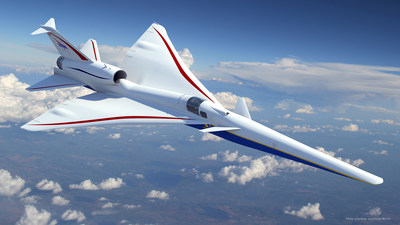Collins Aerospace goes supersonic with win on new X-59 QueSST demonstrator aircraft
— Collins and Lockheed Martin to jointly develop tailored Pro Line Fusion® avionics
— EVS camera will enable pilots to land without a forward window
— Aircraft could enable supersonic commercial travel over land
PR Newswire
CEDAR RAPIDS, Iowa, Jan. 17, 2019
CEDAR RAPIDS, Iowa, Jan. 17, 2019 /PRNewswire/ — In line with its vision to redefine aerospace, Collins Aerospace has been selected by Lockheed Martin to provide avionics for the new X-59 Quiet Supersonic Technology (QueSST) aircraft. The X-59 is being developed by Lockheed Martin for NASA to collect data that could make supersonic commercial travel over land possible through low sonic boom technology. Collins Aerospace is a business unit of United Technologies Corp. (NYSE: UTX).

Collins will provide developmental engineering support to tailor its Pro Line Fusion avionics to the specific requirements of the X-59. By jointly developing software applications side-by-side, Lockheed Martin will receive an optimized solution which will also include Collins’ award-winning touchscreen primary flight displays with tailored multi-function windows, head-up display (HUD) symbology, synthetic vision, ARC-210 communication radios, and a suite of navigation and surveillance equipment. Lockheed Martin will house a System Integration Lab for the Pro Line Fusion avionics at its facility in Palmdale, California.
In addition, Collins will provide a dual multi-spectral enhanced vision system (EVS-3600). In order to achieve supersonic speeds with a low sonic boom signature, the X-59 must have a long and slender shape. This shape also makes a forward-looking window impractical. The EVS-3600 will enable pilots to land in nearly all conditions using advanced visual sensors leveraging long wave, infrared technology.
“Our industry-leading avionics, combined with one of the most advanced EVS cameras in the market, will add to the safety and efficiency of this forward-leaning aircraft,” said Dave Schreck, vice president and general manager for Military Avionics and Helicopters at Collins Aerospace. “We look forward to working with Lockheed Martin and NASA to play an integral role in making quiet supersonic travel over land possible for passengers.”
The X-59, which is expected to take its first flight in 2021, is designed to create a sound about as loud as a car door closing, instead of a sonic boom. It will be used to collect data on the acceptability of the quiet sonic boom generated by the aircraft, helping NASA establish an acceptable commercial supersonic noise standard to overturn current regulations banning supersonic travel over land.
About Collins Aerospace
Collins Aerospace, a unit of United Technologies Corp. (NYSE: UTX), is a leader in technologically advanced and intelligent solutions for the global aerospace and defense industry. Created in 2018 by bringing together UTC Aerospace Systems and Rockwell Collins, Collins Aerospace has the capabilities, comprehensive portfolio and expertise to solve customers’ toughest challenges and to meet the demands of a rapidly evolving global market. For more information, visit CollinsAerospace.com. Follow us on Twitter: @CollinsAero
About United Technologies Corporation
United Technologies Corp., based in Farmington, Connecticut, provides high-technology systems and services to the building and aerospace industries. By combining a passion for science with precision engineering, the company is creating smart, sustainable solutions the world needs. For more information about the company, visit our website at www.utc.com or follow us on Twitter: @UTC.

![]() View original content to download multimedia:http://www.prnewswire.com/news-releases/collins-aerospace-goes-supersonic-with-win-on-new-x-59-quesst-demonstrator-aircraft-300780304.html
View original content to download multimedia:http://www.prnewswire.com/news-releases/collins-aerospace-goes-supersonic-with-win-on-new-x-59-quesst-demonstrator-aircraft-300780304.html
SOURCE Collins Aerospace
